
Atlas F1 Editor in Chief
After years of steady courtship, bringing flowers and batting her eyes, Atlas F1's Biranit Goren was finally invited to a romantic dinner with her favourite man in Formula One: Michelin's head of competition Pierre Dupasquier. Several hours later and after many litres of alcohol, the Frenchman delivered one of the most revealing and in-depth interviews ever seen in Formula One. Find out why Michelin offered to give up any tyre testing at all, how their partners reacted when they offered to help Bridgestone, why Sauber switched to the French company, and how the famous 2003 Tyre Gate was just a deception. And all this is just for starters - there's more to come next week...
I always knew that one day, when I sit down to write a feature on Michelin's legendary director of competition, this confession would be the first thing I'd have to get off my chest.
We thought of going together to a World Rally Championship event last year; I couldn't make it. Then we tried to arrange a trip to the 24 Hours of Le Mans this year; he bailed out. Eventually, with so much time gone by, I suggested we just do it in his office. "Maybe he can take you to a nice restaurant, you can have dinner and talk," Severine Ray, Michelin's press officer suggested. "Well, to be honest, I already know what I'm going to write," I said, "I just need his quotes to fill in the blanks!"
Pierre showed up, smiling as always. "I'll title the article 'Mon Ami Pierre'," I told him, and revealed my first line of the article. "Ohhh, then we must do something romantic!" he said, eyes sparkling. He exchanged some fast words in French with Severine, before she turned to me and said: "we will arrange a romantic dinner in Paris, oui?"
Several weeks later - after the champagne, red wine, gin & tonic (beers for him), and a feast of the finest French cuisine - I am left with five hours of taped conversation (ok, the last hour isn't worth much, given that we were already drunk) and with absolutely no idea what to write, that could do any justice to one of the last remaining giants in Formula One.
"Happy birthday!" I said when I finally found him, Edouard Michelin and the entire senior French staff seated with him for lunch.
"Ohhhh, thank you so much!" he said, his eyes twinkling with mischief as ever, his face wrinkled up warmly. "But you know, it's not my birthday until July."
"Whaaat?" I gulped, "But I was told you're 65 years old this weekend!"
"I'm actually 67, but thank you," he laughed.
That pretty much sums up my relationship with Dupasquier: I would bring him flowers for his birthday, but I'd have absolutely no idea when it actually is.
It also says everything there is to know about Formula One journalists: don't believe a word they tell you - they don't know what they're talking about. So with that in mind, I'd better now let Pierre do the talking.
Les Hors d'Oeuvre - a Few Nibbles of Current Affairs
BG: OK, let's first of all talk about some of the recent developments that Michelin is involved in. With Jaguar now sold to Red Bull, are you going to supply them with tyres?
BG: They will probably have to pay you for the tyres, I'm guessing
Dupasquier: "Oh, yes. We don't want to abuse it, to make money from it, we're just trying not to spend more money - and the price we ask is our normal rate."
BG: What about Sauber? It was announced earlier this month that they will switch from Bridgestone to Michelin next year. I'm assuming they won't be paying you?
Dupasquier: "They are also paying for it. Peter Sauber even said, when asked why he is switching to Michelin, that he's so convinced Michelin will give him an advantage that he's prepared to pay for it."
BG: You know, one of the things that everybody's wondering about, is whether Sauber won't somehow transfer information about Michelin to Bridgestone via Ferrari, given that Sauber and Ferrari work together.
Dupasquier: "That's right, we are keeping that in mind. But we have not yet defined the level of advanced technology we will provide Sauber. We will give them all our support on the tyres, of course, but as far as development goes, it depends. For example, we developed in-house some software that is absolutely confidential which is useful for developing concepts for the future - to integrate tyres in very sophisticated models and stuff like that. So perhaps this will not be part of the deal, we'll see. We're prepared to do anything that has to be done, but at the same time, as you pointed out, since they have a very privileged relationship with Ferrari - at least in 2005 - we will evaluate that situation carefully."
BG: I don't think Sauber will intentionally transfer data - I am sure there's confidentiality clause in your contract - but if they test with Ferrari at Fiorano, for example, you won't be able to monitor it.
Dupasquier: "That's right. So they may not be allowed to test with Ferrari in Fiorano privately anymore."
BG: Is that a condition you made?
Dupasquier: "No, not yet. Right now, we only made with Sauber a gentleman's agreement - we did not finalise the contract yet, in all details and in writing."
BG: Do you know why they decided to switch? You've been talking to Sauber for a long time, but before Brazil last month, at least, Sauber were inclined to stay with Bridgestone. So what changed since then?
"To be clear: I don't think they blame Bridgestone for not giving them the appropriate tyre. That's not the case. They certainly had full access and they told us they had the same tyre as Ferrari, the same options, the same support, and so on. But they are convinced that with Michelin they will be much closer to their competitors, primarily BAR, Renault or McLaren."
BG: So now you are going to supply seven of the ten teams. According to the regulations, you don't have to supply more than six, though
Dupasquier: "Absolutely correct, but we did not know - when we signed with Sauber - we did not know anything about Jaguar."
BG: Let's assume that tomorrow Jordan came to you and said, 'we're willing to pay for your tyres'. You will take them on as well?
Dupasquier: "No! No, no way. With the new regulations next year - as far as the number of tyres that will be made available for the teams over a race weekend - we have the capacity, the resources, to do what we are doing now, because we will not be producing as many tyres as we did in 2004 for each race weekend. But we cannot produce more than that."
BG: But you know, you are very nearly becoming the sole tyre supplier...
Dupasquier, laughs: "Yes, it seems that way!"
BG: So maybe this is a sign for the future? You always said Michelin does not want to be a single tyre supplier, whereas Bridgestone said they do want to stay in Formula One, but in reality, events are actually turning Michelin into the single tyre supplier
Dupasquier: "In the meeting of the team principals [during the Brazilian Grand Prix], they said again that they want a single tyre supplier in 2006. We'll see. There's a meeting of the Formula One Commission in Monaco on the 9th of December. I will attend it, since Michelin is for this year the representative for the tyre manufacturers. I don't know what will happen, but we didn't change our position: we don't like the idea of a single tyre supplier; we prefer to have competition. And if they go this way, it means that Formula One is becoming Formula 3000. But, at the same time, we'll wait and see - and if we have a request to tender or anything, then the company will make a decision at that time."
BG: But with seven teams on Michelin, if the teams decide to go to a single tyre supplier in 2006, the majority of the teams are going to have a huge problem if it's not Michelin
"It proved to me that in Formula One, after just a few kilometres, in a few laps, the engineers are capable of achieving a decent setup no matter what you give them. And for us it was absolutely proof that the aerodynamics of those English cars was so good compared to others - Ferrari in particular - that they won the race. They were absolutely dominant, maintaining the tyres constantly, while Ferrari was in shit after just five laps.
"So that also proves to me that Formula One teams have the ability to adapt to any new supplier. It's not a big problem."
BG: Right now, the main topic of discussion is restriction of testing. Nine of the ten teams - seven of them are your partners - signed an agreement to restrict testing during the season to only 24 days. Ferrari haven't signed it but if they were to agree to it as well, the implication would be that realistically, Bridgestone will have 24 days of testing, whereas you will have about 120 days
Dupasquier bursts out laughing. "On the day before the meeting, Bernie asked me, 'are you prepared to accept that the Michelin teams will limit their testing to such and such days, and Ferrari does whatever they want?' I said, 'Hell, no!' - I'm not prepared to accept that. But it may well be what will happen - only press and public pressure on Ferrari may dissuade them from testing whenever they want, because this is just a gentlemen's agreement and they didn't sign it. They can test whenever and wherever they want, period. And they can do it. That's it. Nobody can go against them with legal threats or rules, or anything like that."
BG: Well, forget about the legal side. I'm talking about the competition side: right now, there's no equality between how much testing Bridgestone can do and how much testing you can do.
Dupasquier: "That's how people see it, but in reality, within the five teams we test with, we don't do the level of testing that Bridgestone does with Ferrari. We don't have a lot of machines and drivers to do that. It's not so simple. Bridgestone and Ferrari are testing bang, bang, bang - they can test between 10 or 12 different tyres per day, it's incredible. Normally we have 4-5 sets of different tyres per day for all our main partners, so really if you look at it in details, it's in fact not a question of how many days or teams each has, but the level of involvement."
BG: But it is about quantity, after all; the teams are talking about restricting the number of days, that's quantity. And if Ferrari accept this agreement, you're still left with 24 days of testing for Bridgestone and 120 days for Michelin. Potentially, at least. So you do have a huge advantage over Bridgestone
Dupasquier: "Well, we discussed that in Brazil. Bernie came to me and said 'I'm commissioned by the teams to tell you that we would like to have a single tyre manufacturer in 2005' and I said, 'hang on, who is it going to be?' He said, 'Michelin'. And I said, 'well we may not agree to it'. First of all, it will ruin the Formula One spirit and the momentum of Formula One. But more importantly, it will give Ferrari another five tenths at least advantage on their competitors, because we have the feeling, we are persuaded - and it has been proved later on in the race in Brazil - that we are giving our teams a significant advantage because of the Michelin tyres against Bridgestone. Bernie said, 'oh hell I didn't think about that aspect'. Fine. So he said, 'give me a proposal'.
"I wrote to him a paper saying that we, Michelin, as a tyre manufacturer, we will not need any kilometre of specific tyre testing next year, starting with Brazil 2004.
"I wrote him this letter and gave it to our partners as well, and I saw that they don't understand it. They cannot imagine that they will not be asked by us to test tyres. But I made it clear to them and said: we don't need tyre testing."
BG: If the teams didn't understand it, you can imagine how I feel right now! I am utterly confused - why don't you need testing? We all think that you do. We all think the reason there is so much testing, is because of the tyres, and now you're telling me you don't need it?
Dupasquier: "Absolutely! It's just what the teams are saying to cover their ass, that is the problem! Mr. Briatore said that 80% of the testing kilometres are meant for tyre testing, I said bullshit! I don't need tyre testing kilometres, that's it. Finished."
BG: Why not?
Dupasquier: "Because we'll have enough kilometres on the team's testing that they run for themselves, and they don't admit that. They blame the tyres for that - easy. It's the umbrella that they open for that. I'm convinced that the kilometres that the teams will do for their own engine, gearbox, chassis, aerodynamics testing - I will be capable, according to the number of cars we have, thank you very much, to make enough kilometres on our tyres for the test we need.
"In such a situation, I will obviously have an advantage over Bridgestone because we have more partners. So I told Jean Todt in Brazil that I understand that, I'm not stupid, and I'm personally prepared to give them one or two more tyre sets per car per day, to help Bridgestone a little bit. That is, if we agree on three sets of tyres per car per testing day, then Bridgestone and Ferrari will run four or five sets per testing day. I agreed to that because I think they are at a disadvantage.
"But our partners don't agree, they say 'they have to die, bastards, no way'" - Dupasquier giggles - "but that's our partners. I myself will say, yes, we should give Ferrari some more sets per day of testing."
BG: OK, I'm really confused. Everybody thought that you have to test and now you're telling me that you don't have to. What is this all about, then?
Dupasquier: "I'm not saying we will not test tyres - I'm saying we don't need specific tests for tyres. With the tests the teams will undertake for their own sake, running on our tyres will be enough for us to find out from the track what we need, and any other test will be done in-house."
BG: What you're saying is that you don't actually need specific testing for tyres, it's enough for you if you gather data from whatever running the teams are doing anyway?
Dupasquier: "Yes, exactly!"
BG: The thing is that you can probably do it, because you always had the philosophy that it's better to produce a tyre for all - work collectively rather than to concentrate on one team.
"So it proves that when you design the tyre, the best possible tyre for Formula One, according to the rules, then all cars should be happy with that tyre. If we improve on the front, everybody will be happy on the front. If one team doesn't like what we feel is an improvement, and others feel the same way, we tell them 'look, it is a better tyre. Why don't you try to take advantage of it?' So they have to re-adjust the car, and try to get the advantage - it's always good to get advantage of an improvement somewhere.
"Take the big test in Monza, before the Grand Prix this year, for example: we gave our partners 15 different sets. We built the programme with each one separately and they then told us - I like the N option, I like the M option, I don't like the O option or the P. Good. And at the end of the day we opened the book and compared notes, and what did we see? Ohhh! Everybody liked the same!"
BG: Really?
Dupasquier: "It's not amazing!"
BG: Well, it is to me, because I remember other Bridgestone teams complaining that Bridgestone are making the tyre for Ferrari, and if it would have been the same as you say, they should have actually gained from it because Ferrari do so much testing.
Dupasquier: "Well, for me this is a mystery. When you get a result, in motorsport you get the result of everything: the driver in the car, the tyres, the car, the conditions. You have great performance - where does it come from? We don't know. If you have another car with the same tyre, the same performance - but one is winning and one is not winning; if one guy finds the tyre fantastic and two other guys find the tyre shit, then you have to ask the question, what's going on?
"Then you go to the car, you find the balance, the adjustment of the roll bar, or something like that. So definitely in the technical point of view, when you work close to the rules with different machines and different drivers, you get the proper answer to your question - is it an improvement? It's not. If you only have one car and the guy likes it, you think it's an improvement - but maybe it's not. So if you really, honestly, want to understand, to see what's going on and to improve something, it's only with enough machines that you can be sure that tyre-wise, it's what you are looking for."
Dupasquier: "We have the same question, and in our case we looked this year at Sauber. It's a good car, it's a competent team, Giancarlo Fisichella is very fast, and so they're a good indication. And it's the only one we have. By looking only at Ferrari and Bridgestone, you cannot do anything."
BG: If we look at Sauber, it's also a bit confusing. Because at the beginning of the year they weren't very good, but by the end of the season they had a heavily modified chassis, we were seeing some elements from the wind tunnel, and they have a Ferrari engine and gearbox
Dupasquier: "Yes. The team is decent, the driver is fast, and the car is not a rubbish car. So if they have a significant improvement during the season and the tyre is the same, you can compare their performances and you can see that it's the car that improved rather than the tyre.
"We have the same question. It's easy for them to see what's going on with us. Remember, last year we get McLaren dominating at the beginning of the season but then brrrrrrrrr, for reasons we know of. And the Williams hitting a hard time at the beginning and then woaaaaaah, picking up and finishing... Imagine we only had one team, whoever it is; or imagine this year we didn't have BAR? We'd have been in deep shit."
BG: Without BAR?
Dupasquier: "Yes. Because all our partners - Williams and McLaren and Renault - had no consistent performances. They each got a win, in Monaco or in Spa or in Brazil, but there were times when they were shit. And what's in common? The Michelins, so the Michelins don't work. But at the same time BAR had [Jenson] Button going on the podium every time, so they say ooops, sorry guys, it's not the tyre. The car, the BAR car, is a good car but it's not that fantastic compared to McLaren, Williams, Renault, and so on. So the tyre must be good."
BG: OK, I'll tell you what's the conspiracy theory on the Internet.
Dupasquier, giggling: "Ohhh, I like conspiracy theories!"
Dupasquier: "Definitely a nice one! Well, you can always build theories like that. But the first thing I have to say is that BAR modified significantly their car according to our tyres, so it's not the Bridgestone car they're running.
"But most importantly, we did not modify our tyre - this year we ran the same tyre as we did last year, before Hungary. The only thing we changed was added a clear mark on both sides of the tread, to make it more visible and the measurement easier. Other than that, we did not modify anything to it - we didn't even change the mould, it's the same mould. So the conspiracy is therefore not valid."
BG: If it's the same tyre, then why wasn't it legal - according to what the FIA said - in the 2003 Hungarian Grand Prix, but in 2004 is was legal?
Dupasquier: "Well we believe it was always legal - before and after 2003. But after all the mess last year, the FIA have been very fair in saying, 'OK, we agree on the fact that the tyres have to be measured when they are new' - because afterwards you get on the curbs, you get trace of contact everywhere, it's a mess, not just the side wall. The whole problem was the interpretation of what's a tread? If you remember, Charlie [Whiting] wrote to the teams after Hungary last year and said the tread is the part of the tyre which is constantly and permanently in contact with the ground. And obviously no one part of the front tyre is constantly and permanently in contact with the ground. So once this was clarified, we talked some more and really there was no argument anymore."
BG: I don't get it. Are you telling me that since then, and throughout 2004, the FIA scrutineers do not measure the tread width of the front tyres after they are used?
Dupasquier: "No, they don't. And they didn't ask us to provide input on how to do that either."
BG: Really? So all this affair last year - with Ferrari accusing you of cheating - it sounds like all this was just a storm in a tea cup...
Dupasquier: "Oh yeah, somebody just wanted to spoil the World Championship last year, in case they don't win..."
BG: Come on, this is important; you're telling me that... The message that Charlie Whiting sent the teams last year stated that from there on, the FIA was going to measure the tread width on worn tyres
Dupasquier: "Yes."
BG: And you're telling me they don't do it
Dupasquier: "No, the continue to measure it on fresh ones. They don't care. Somebody was pressuring them to say, why don't you find something to discredit the Michelins..."
BG: Somebody? Ferrari
Dupasquier: "Yeah, yeah. Sure."
BG: Michelin even threatened to sue Ferrari's technical director, Ross Brawn, for slander last year, after he said in an interview that you cheated....
Dupasquier: "We could have done that, because it's not fair to put the name of a company like Michelin, with 130,000 employees, under pressure for some rubbish like that. But this was not my responsibility."
BG: This is quite shocking what you're telling me. I remember last year, McLaren's Ron Dennis and Williams's Patrick Head and you yourself - you all said the biggest problem is how to measure the tread on a worn tyre
Dupasquier: "Yes! They give us 270mm - we take 269.9mm - if you give up any percent, you are not competitive in Formula One. So we know we are marginal, on purpose. That's why we wanted to know exactly when and how the FIA measures, to make sure that we are right at the limit."
BG: OK, in Hungary 2003 Charlie Whiting checked the used tyres, and he found that the Williams front tyre's tread width after the race was a few millimetres more than 270
Dupasquier: "Yes, absolutely."
BG: OK. So how did he measure it? What did he do?
Dupasquier: "He looked at the tyre and he measured from one side to the other, until no scratch was visible. On one side it was easy, but on the outside wall of the tyre he went until you couldn't see any scratch on the rubber of the tyre's side wall."
BG: So it's visible
Dupasquier: "Oh yeah. And in addition, the extreme of the tread is worn out, so it becomes lower and close to the side wall."
BG: OK, clarify this for me, then: if in China, for example, Charlie Whiting would have done the same thing after the race - measured the tread width of the used tyres - is there a chance that he would have again found it to be more than 270mm?
Dupasquier: "Absolutely, oh yes, absolutely. And we would have told him in response that this part of the tyre is not in constant and permanent contact with the ground, so it's not the tread."
BG: So really, everything that happened last year was just...
Dupasquier: "Absolutely bullshit, you can say it! Absolutely."
BG: That's crazy...
Dupasquier: "Yes. That's Formula One..."
We fall into momentary silence, only to be interruped by the Maitre d'. "Monsieur, mademoiselle, would you like to order now?"
The dinner has just begun.
I love Pierre Dupasquier.
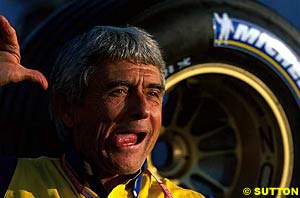 In fact, it's been well over a year since the idea came up - to sit down for a comprehensive chat with Pierre, after over thirty years in motor racing, in an environment that is not the Formula One paddock. We see each other every Grand Prix - kiss hello or hug goodbye, have lunch, talk about the racing. But in the paddock, everyone wants a piece of Dupasquier. For my interview, I wanted him all for myself.
In fact, it's been well over a year since the idea came up - to sit down for a comprehensive chat with Pierre, after over thirty years in motor racing, in an environment that is not the Formula One paddock. We see each other every Grand Prix - kiss hello or hug goodbye, have lunch, talk about the racing. But in the paddock, everyone wants a piece of Dupasquier. For my interview, I wanted him all for myself.
Last year, during the Monaco Grand Prix, a fellow journalist mentioned to me in passing that Pierre Dupasquier was celebrating his 65th birthday that weekend. In turn, I rushed out of the paddock to the nearest flowers shop in town, bought a bouquet of yellow flowers wrapped in blue ribbon and then walked back to the paddock in search of Dupasquier. Michelin's motorhome was buried deep inside the mazed paddock, a walking distance past virtually every other motorhome. I'd responded to dozens of "Nice flowers, what's the occassion?" before I hit the shining blue motorhome, and by then half the paddock knew that Pierre was 65 years old that weekend.
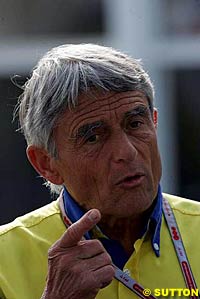 Dupasquier: "We are currently in discussion with them, because we've been asked by Ford, before they sold the team, to accept the possibility of supplying whoever buys it with tyres if needed. We accepted that, because we were asked by Ford. Now that they sold it to Red Bull, we will keep our word, especially since the management and staff are still the same, so it's basically the same team. I admit that for us it's not the same challenge, because it's not backed by Ford, but they have asked us and so we made Red Bull an offer, and they have to decide on it very rapidly, because they're supposed to run next week in Barcelona. But so far nothing is done."
Dupasquier: "We are currently in discussion with them, because we've been asked by Ford, before they sold the team, to accept the possibility of supplying whoever buys it with tyres if needed. We accepted that, because we were asked by Ford. Now that they sold it to Red Bull, we will keep our word, especially since the management and staff are still the same, so it's basically the same team. I admit that for us it's not the same challenge, because it's not backed by Ford, but they have asked us and so we made Red Bull an offer, and they have to decide on it very rapidly, because they're supposed to run next week in Barcelona. But so far nothing is done."
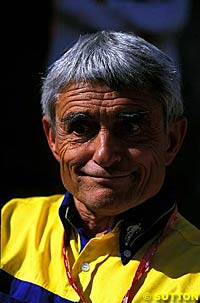 Dupasquier: "Nothing changed. Peter Sauber has been asking us for tyres for two years now. In any occasion we'd meet, he would say, 'When are you going to give us tyres?'. And after the race in Brazil, more specifically, he was convinced that because of the Bridgestone tyres he is far from the optimal results he is capable of achieving with the current car. Because of their new wind tunnel, they improved significantly the aerodynamics and they are convinced that the Bridgestone tyres are not giving them the maximum results.
Dupasquier: "Nothing changed. Peter Sauber has been asking us for tyres for two years now. In any occasion we'd meet, he would say, 'When are you going to give us tyres?'. And after the race in Brazil, more specifically, he was convinced that because of the Bridgestone tyres he is far from the optimal results he is capable of achieving with the current car. Because of their new wind tunnel, they improved significantly the aerodynamics and they are convinced that the Bridgestone tyres are not giving them the maximum results.
 Dupasquier: "No, not necessarily. I always remember how, in 1981, after Goodyear withdrew from Formula One, I told Bernie [Ecclestone] that I was capable, according to the machines I had, to produce only four sets of identical tyres for every driver for the weekend, and he said 'OK, it's fine with me'. And we did it. The English guys at that time never saw a radial Michelin tyre before. Never. But in the first race of 1981, in Long Beach, our teams absolutely dominated.
Dupasquier: "No, not necessarily. I always remember how, in 1981, after Goodyear withdrew from Formula One, I told Bernie [Ecclestone] that I was capable, according to the machines I had, to produce only four sets of identical tyres for every driver for the weekend, and he said 'OK, it's fine with me'. And we did it. The English guys at that time never saw a radial Michelin tyre before. Never. But in the first race of 1981, in Long Beach, our teams absolutely dominated.
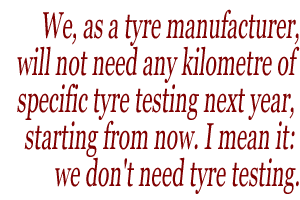 I mean it: we don't need tyre testing. Let our partners go testing in Barcelona if they want; in Valencia, Jerez or anywhere, and we will be there with tyres. We have agreed to restrict the number of tyre sets per car per testing day - it will be something like two or three sets, whatever - and we will manage with the existing testing kilometres to find our way for our tyres.
I mean it: we don't need tyre testing. Let our partners go testing in Barcelona if they want; in Valencia, Jerez or anywhere, and we will be there with tyres. We have agreed to restrict the number of tyre sets per car per testing day - it will be something like two or three sets, whatever - and we will manage with the existing testing kilometres to find our way for our tyres.
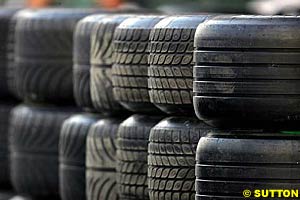 Dupasquier: "Not exactly. You're right, but it's not exactly the intention. The intention is to say OK, we can do that - work for each team, test with each team, and they get the tyres they like. But in fact what happens in Formula One is that the cars are physically very close to each other, every car. They are built under the same rules and the rules are absolutely strict in weight, and sizes of everything. So at the end of the day, if you translate that tyre for each wheel, in tyre definition, you get the exact same tyre. There's no difference. Sure, a little setup change can create a little bit of understeering and destroy your front tyres and you lose a race. But you lose a race by a few seconds after one and a half hour - physically, it's nothing.
Dupasquier: "Not exactly. You're right, but it's not exactly the intention. The intention is to say OK, we can do that - work for each team, test with each team, and they get the tyres they like. But in fact what happens in Formula One is that the cars are physically very close to each other, every car. They are built under the same rules and the rules are absolutely strict in weight, and sizes of everything. So at the end of the day, if you translate that tyre for each wheel, in tyre definition, you get the exact same tyre. There's no difference. Sure, a little setup change can create a little bit of understeering and destroy your front tyres and you lose a race. But you lose a race by a few seconds after one and a half hour - physically, it's nothing.
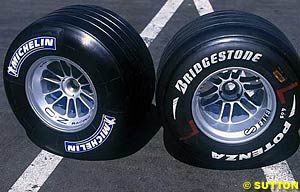 BG: So how do I, as a fan with no technical knowledge, how can I tell by watching the races and qualifying which tyre is better, Michelin or Bridgestone? What are the signs for me? Ferrari are winning, so it's easy to think that it's Bridgestone
BG: So how do I, as a fan with no technical knowledge, how can I tell by watching the races and qualifying which tyre is better, Michelin or Bridgestone? What are the signs for me? Ferrari are winning, so it's easy to think that it's Bridgestone
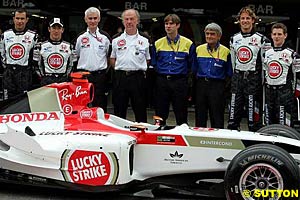 BG: Then you'll love this one. Some fans believe that this year's BAR was designed initially for Bridgestone, which was a narrower tyre in 2003, whereas the other Michelin teams began designing this year's car before the Hungarian Grand Prix last year, before the whole 'Tyre Gate' affair. So the conspiracy theory is that BAR were doing well this year because their car was built for narrower tyres. And because Michelin had to change to narrower tyres after Hungary last year - when your front tread width was deemed to be outside the permitted 270mm of the regulations - BAR has the most suitable car. That's the conspiracy theory.
BG: Then you'll love this one. Some fans believe that this year's BAR was designed initially for Bridgestone, which was a narrower tyre in 2003, whereas the other Michelin teams began designing this year's car before the Hungarian Grand Prix last year, before the whole 'Tyre Gate' affair. So the conspiracy theory is that BAR were doing well this year because their car was built for narrower tyres. And because Michelin had to change to narrower tyres after Hungary last year - when your front tread width was deemed to be outside the permitted 270mm of the regulations - BAR has the most suitable car. That's the conspiracy theory.
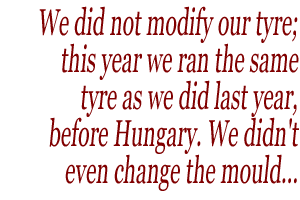
Coming Up Next week: Les Entree - Politics in a Rich Sauce of Cheating Allegations, with a Side Dish of Ferrari on Michelins...
|
Contact the Author Contact the Editor |
Please Contact Us for permission to republish this or any other material from Atlas F1.
|
Volume 10, Issue 46
Exclusive
Dinner in Paris with Pierre Dupasquier
Season Review
How Would F1 Score in Other Series
Season Strokes: 2004 in Review
Columns
On the Road
Elsewhere in Racing
The Weekly Grapevine
> Homepage |